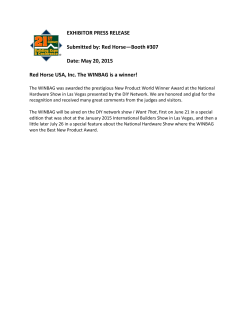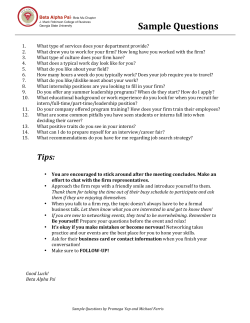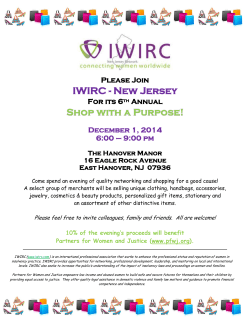
Engaging citizens in the smart city project through DIY networking
Engaging citizens in the smart city project through DIY networking Panayotis Antoniadis, Ileana Apostol, Katalin Hausel 2nd International Conference on Internet Science Brussels, May 27th 2015 Smart cities Engaged citizens Do-It-Yourself Networking firechat Thinking outside the Internet http://www.jrbaldwin.com/tidepoolswifi/ Why? DIY networking has special characteristics - De facto physical proximity - Ownership and control - Inclusive access and tangibility - Options for anonymity and privacy The Internet is a dangerous place ... … but also very attractive Photo: bekathwia@flickr DIY networking for location-based collective awareness Zurich, November 2014 Without location disclosure to third parties Zurich, November 2014 Customized according to the context Photo: Tridib Banerjee Affirming difference Protecting and encouraging freedom of expression Express yourself Lisbon, June 2013 Facilitating contact … while preserving privacy and lowering commitment Bonus reason 1: resilience Photo: Iwan Baan Bonus reason 2: small data Internet science without the Internet - network evolution - self-organization - privacy - behaviour - and more … Antoniadis & Apostol. (forthcoming). Collective awareness as a public good: bottom-up experimentation with the NetHood toolkit, First Monday, special issue on Internet Science But ... “The only common interest I have with my neighbor is that we both like my wife” ... and more challenges - Usability issues - Failures and abuse - Competition with the Internet - Political and social issues - High complexity! The details matter … http://nethood.org Software DIY networking Input Output Symbolic elements Which is an appropriate boundary object? Computer science Electrical engineering Networking Human-Computer Interaction Social sciences Economics Urban planning Sociology Ethnography Boundary object? Technology Artifacts Concepts Locations Industry ICT Urban design Smart cities Practitioners Activists Hackers Artists Civil society Dagstuhl seminar on “DIY networking: an interdisciplinary approach” http://www.dagstuhl.de/14042/ Boundary object: DIY networking Computer science Social sciences Electrical engineering Networking DIY networking Urban planning Sociology P2P systems Ethnography Human-Computer Interaction Activists Industry Occupy.here PARC http://www.dagstuhl.de/14042 RedHood WiFi First interdisciplinary workshop on DIY networking → next year will take place at NordiCHI 2016 Qaul.net Hybrid letterbox obsy liberouter http://diynetworking.net Boundary object: Policy Boundary object: Framing Offline networks discussion at Transmediale festival, Berlin, January 31 st 2015 “Like the first days of the Internet but at the city scale” Your Offline Network Logo? A DIY networking toolkit? Service level software Bottom-up real-life experimentation Forums, questionnaires, apps Input/Output Audio, projections, analogue Context-specific guidelines and customization Physical interventions Street furniture, artifacts Networking Hardware, scripts Data analysis Inspiration example: the yellow chair Photo: Anab Jain http://superflux.in/work/yellowchair-stories Eleni Dimopoulou, Evangelia Kokolaki, Antoine Loriette, Anja Mück, Vasilis Niaros, Michael Smyth, Andreas Unteidig 3rd EINS summer school: From smart cities to engaged citizens http://internet-science.eu/summer-school-2014 Inspiration example: the stupid forum By Miltos Manetas http://stupidforum.com Unmonastery workshop, Transmediale Festival, Berlin February 2014 https://github.com/nethood/toolkit Unmonastery workshop, Transmediale Festival, Berlin February 2014 The hybrid letterbox By the Design Research Lab, Berlin University of the Arts http://www.design-research-lab.org/?projects=hybrid-letter-box Community Now? By the Design Research Lab, Berlin University of the Arts Interdisciplinarity (is about compromises) ● efficiency vs. sustainability ● modelling vs. context-specificity ● solutionism vs. ambiguity http://poachedmag.com/ http://www.futuristspeaker.com/ Lessons learned so far - Balanced groups and respect - Low expectations - Boundary objects - Fun and the joy of diversity A growing network ... The DIY networking roundtable Theory Place making The stranger Field research Speculative design Roundtable 14h00-17h00 DIY networking as a mediator for interactions between strangers 1) Context matters Space diagnosis, participant Observations, place making (urban planning) 2) People matter The role of the stranger/catalyst (artistic urban interventions) Katalin Hausel MA in Philosophy, MA in History, MFA in Visual Art William H. Whyte 1980: Social Life of small urban spaces http://www.pps.org/reference/grplacefeat/ Kevin Lynch 1960: Taxonomy of Images ● landmarks, nodes, edges, paths, districts Roundtable 14h00-17h00 DIY networking as a mediator for interactions between strangers 1) Context matters Space diagnosis, participant Observations, place making (urban planning) 2) People matter The role of the stranger/catalyst (artistic urban interventions) Field research Identify target locations and expected interactions Roundtable 14h00-17h00 DIY networking as a mediator for interactions between strangers 1) Context matters Space diagnosis, participant Observations, place making (urban planning) 2) People matter The role of the stranger/catalyst (artistic urban interventions) Field research Identify target locations and expected interactions (Speculative) hybrid design and future scenarios See you at the DIY networking roundtable! Theory Field research Speculative design
© Copyright 2025









